home | metro silicon valley index | features | silicon valley | feature story
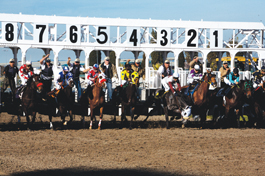
Ride into the Sun
As the resistance drops its suit against the San Mateo City Council, Bay Meadows—California's oldest racecourse and a culture unto itself—looks certain to close
Photographs by John Sebastian Russo
Even champion horses eventually get put out to pasture. Now it's finally Bay Meadows' time too, as the campaign to keep California's oldest racecourse open finally came to end this month, virtually ensuring that, after 74 years, it will close permanently at the end of this racing season. But the Bay Area landmark didn't go out without a fight.
Located on the west side of 101 and just south of Highway 92, the land on which the track sits is a dream location for development—especially with San Mateo in desperate need for an economic boost. Since purchasing Bay Meadows in 1997, the Bay Meadows Land Company (BMLC), owned by the Stockbridge Real Estate Fund, has had its sights set on tearing it down and replacing it with a multiuse development.
For years, rumors have quietly circulated among fans and employees about Bay Meadows' closing. In 2004, the BMLC officially submitted a proposal to redevelop the track. Both the San Mateo Planning Commission and the City Council unanimously accepted the proposal.
In November 2005, the San Mateo City Council voted to allow the demolition of Bay Meadows. Adding insult to injury, the council removed a fund set aside to memorialize the track— a deal that was part of the redevelopment proposal.
The Friends of Bay Meadows, a grassroots organization dedicated to preserving the track, vowed to fight the City Council's decision by getting a referendum on the ballot. The group gathered almost 6,000 signatures in 30 days, far more than the required 4,661, but the city rejected more than 1,000 of those. As a result, the ballot effort fell just short, even after Superior Court Judge Mark Forcum allowed 28 of the contested signatures to pass.
Thus, the course that found its fame when Seabiscuit won two back-to-back Handicap races there in both 1937 and 1938—just three years after Bay Meadows opened—is closing for good. With a suit brought by Friends of Bay Meadows was dropped, there are no more major obstacles keeping the BMLC from redeveloping the property, and word has spread that construction will begin as early as fall of this year. Bay Meadows' racing season ends May 11. With fans and employees still keeping their fingers crossed for an 11th-hour miracle, Metro presents a photographic look at the unique culture of this longtime institution.
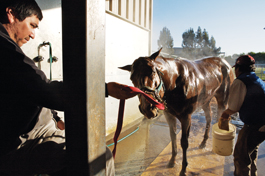
The Athletes
Nearly 700 horses are stabled at Bay Meadows where they receive top-of-the-line care. Depending on the horse's needs, it costs around $3,000 a month to feed, groom, exercise and care for the horses medically. Bay Meadows has hosted races featuring the renowned Seabiscuit, Citation and Lost in the Fog. In 1937, Seabiscuit won back-to-back Handicap races at the track. Citation became the first horse in racing history to earn over $1 million. )
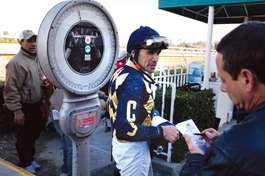
Jockeys
Macario Rodriguez weighs in after a race. The jockeys are weighed in with their saddles at the end of each race to ensure that their weight was properly represented in the racing programs. The target weight for jockeys is 115 pounds; essentially, genetics determines if one can be a jockey or not. Jockeys act as free agents who follow the racing venue with the changing of the racing seasons. The day starts between 5:30 and 6am when they exercise the horses. This will last until late morning. When finished with the morning task, they head back to the Jockey Room where most sleep, relax in the steam room or attend to pre-race rituals until the first race. Jockeys have to always be conscious of their weight in order to keep up with the sport. )
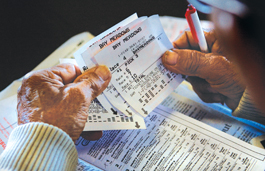
Betting Tickets
Tickets represent momentary hope for the racing fan. Some will place multiple wagers per race in order to increase their odds of winning. They nervously study the tickets, memorizing their content to confirm they have chosen the right horse. As each race starts, fans clinch their ticket as if it was their last hope. Following the race results there are more torn and crumpled tickets strewn around Bay Meadows than celebrating bettors.
Punter's Theater/Simulcast
An elderly patron thumbs through his racing program in Punter's Theater at Bay Meadows. Punter's Theater is an enormous dark viewing hall separated by an island of betting machines in a central room. A long 15-foot path cuts down the right side of both rooms joining them together. On the far end of each room there are five monitors broadcasting the races of the day from across the country. Flanking each room are TVs mounted high on the walls featuring other sports or more horse races. The room is designed to allow patrons to watch simulcast races while in the relative privacy of their own cubicle. There has been a slight decline in visitors to Bay Meadows, as well as other tracks across the nation, for watching live racing. The decline can be attributed, in part, to off-track betting (simulcast) locations, and also younger generations who do not show the same enthusiasm for the sport as their predecessors. )
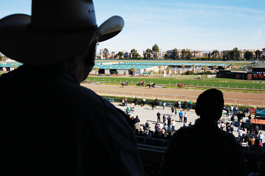
The Fans
Racing fans at Bay Meadows come from many walks of life. During the week, elderly patrons make up a majority of the nearly 2,000 people visiting the racetrack. Weekend races attract larger, more diverse crowds that number between 7,000 and 9,000. Bay Meadows still serves as a popular destination for families and groups of young people on the weekends.
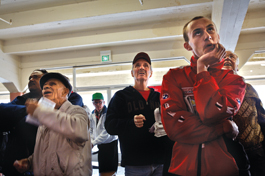
Anticipation
The gates swing open without warning and the intensity of the spectators gradually increases as the horses approach the Stretch. As the horses round the Stretch, yells of encouragement and frustration are hurled at the athletes on the track. Anticipation swells in the faces of the patrons as their eyes remain unshakably fixed on the race. With each race lasting one to 1 1/2 minutes, the bubble of excitement bursts rapidly as the fans return to the hustle of planning the next big wager.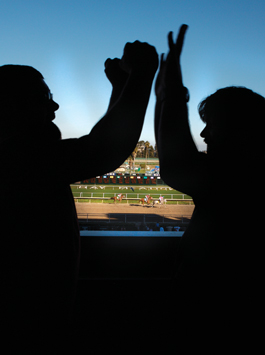
Happy Endings
When William Kyne opened Bay Meadows in 1934, he was hailed as 'the man who brought racing back to California,' following a successful campaign to legalize Pari-mutuel wagering in the state. Pari-mutuel wagering means winners of a race divide the total amount bet, minus taxes and fees to the house. There are no fixed odds, and odds are not final until the pools are closed. There are happy endings for exuberant winners, and with the end of the season looming, fans and employees of Bay Meadows are keeping their fingers crossed for one last long shot.
Send a letter to the editor about this story.
|
|
|
|
|
|